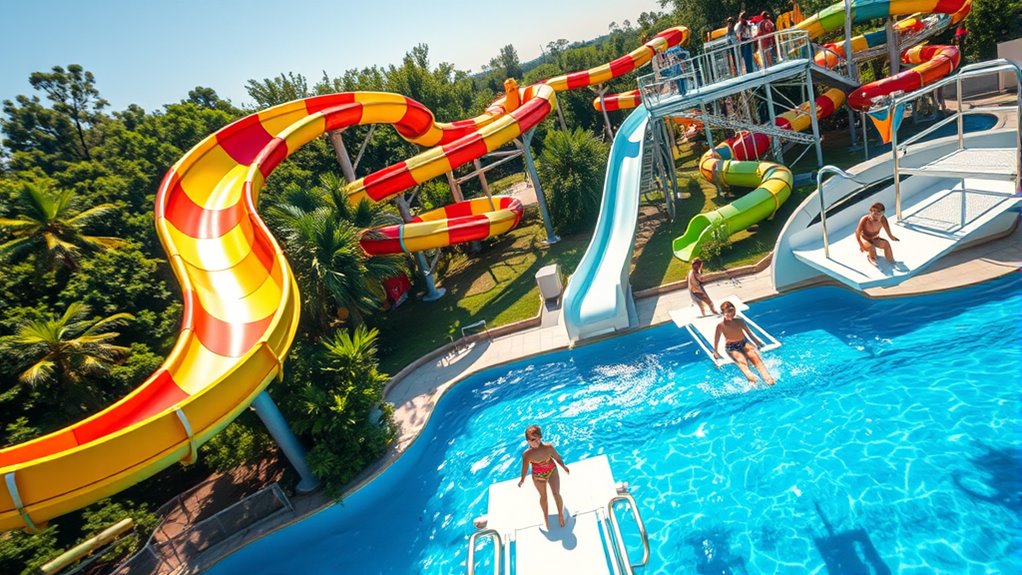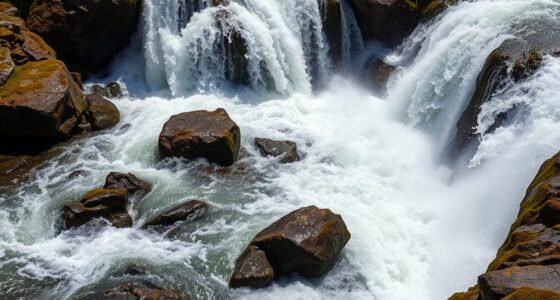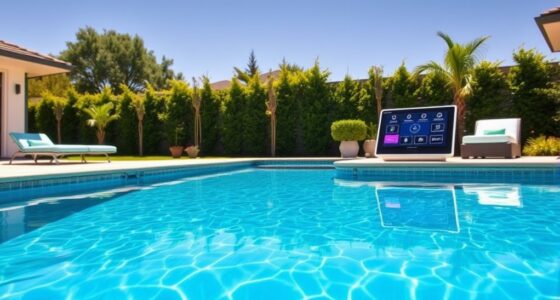Slides and diving boards add excitement and attract visitors, but they come with safety risks and liability concerns. You need to balance fun with proper design, maintenance, and strict safety protocols like signage and supervision. Understanding fall hazards, water depth rules, and equipment inspections helps reduce injuries. By managing these trade-offs carefully, you can create a safe, enjoyable environment—if you’re interested, there’s more to discover on how to achieve this balance effectively.
Key Takeaways
- Balancing excitement and safety requires strict adherence to design standards, signage, and supervision to minimize injury risks.
- Higher slides and diving boards boost fun but increase fall hazards and injury potential, demanding enhanced safety measures.
- Proper surfacing, equipment maintenance, and clear zone management are essential to reduce liability while preserving enjoyment.
- Comprehensive staff training and safety protocols help mitigate legal risks while encouraging responsible user behavior.
- Transparent communication of risks and safety rules fosters a culture of safety without compromising the thrill of water features.
The Appeal of Water Slides and Diving Boards

Water slides and diving boards captivate people of all ages because they offer an exciting way to enjoy the water and feel a rush of adrenaline. These features turn ordinary pools into thrilling destinations, drawing crowds enthusiastic for fun. The thrill of racing down a slide or the jump from a diving board creates a sense of adventure and accomplishment. They provide a quick escape from everyday routines and encourage active play. Whether you’re seeking a high-speed descent or a simple leap into the water, these attractions deliver excitement for everyone. Their visual appeal and the promise of fun make them a central focus at recreational spots. Ultimately, their ability to generate joy and memorable experiences explains their enduring popularity. However, safety considerations and proper liability management are essential to ensure everyone can enjoy these features responsibly.
Common Safety Concerns and Risks
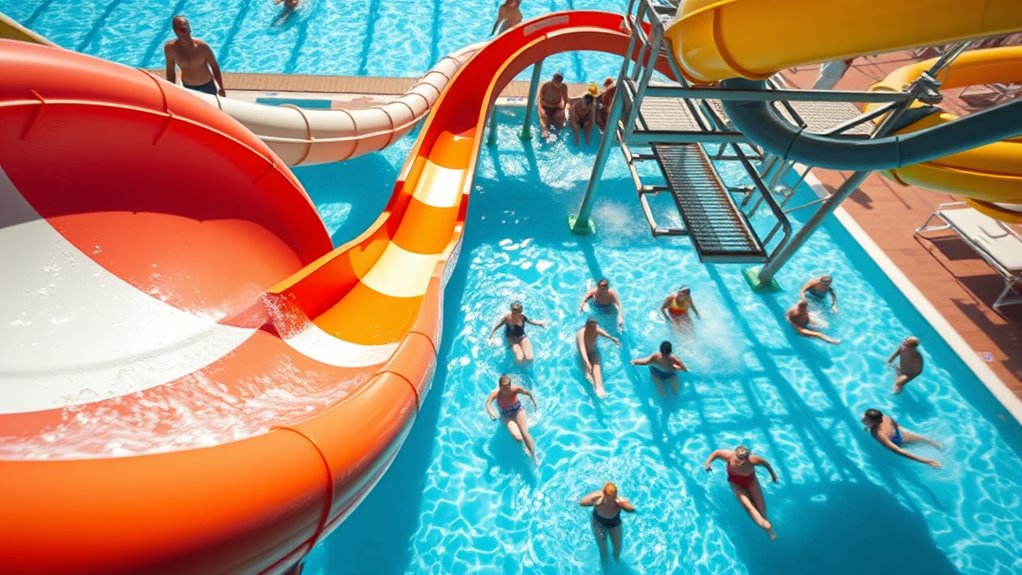
Safety concerns around slides and diving boards are vital to contemplate before using them. You need to watch out for fall hazards and injuries, guarantee water is deep enough, and verify that equipment is properly maintained. Addressing these risks helps keep everyone safe and prevents accidents. Additionally, ensuring that safety signage and instructions are clearly displayed can further reduce the likelihood of mishaps, especially when considering cultural and regional safety practices.
Fall Hazards and Injuries
Because of their height and design, slides and diving boards pose significant fall hazards that can lead to serious injuries. You might slip, lose control, or land awkwardly, risking broken bones, head injuries, or even paralysis. These accidents can happen suddenly, catching you off guard. The thrill of fun can quickly turn into a nightmare if safety measures aren’t in place. Using protective padding and barriers can significantly reduce these risks and improve overall safety.
- Suffering a concussion from hitting the ground hard
- Breaking a limb during a fall
- Sustaining head injuries from awkward landings
- Facing lifelong scars or disabilities from a severe accident
Being aware of these risks helps you stay cautious. Proper supervision and safety equipment are essential to reduce these dangers and keep your experience enjoyable, not tragic.
Water Depth Safety
Have you ever wondered what makes a swimming pool or water slide safe to use? The key factor is water depth. If the water’s too shallow, jumpers risk hitting the bottom, leading to serious injuries. Conversely, overly deep water can pose drowning risks if someone struggles or can’t swim well. Regulations specify minimum depths for slides and diving boards to prevent accidents; for example, shallow areas under slides should be at least 3 to 5 feet deep, while diving zones often require 8 to 12 feet. Always check the posted signs and ensure the water depth matches the manufacturer’s recommendations. Proper depth guarantees safe entry and reduces injury risks, making your swimming experience enjoyable without unnecessary hazards. Additionally, maintaining accurate water depth is essential for overall safety and compliance with safety standards.
Proper Equipment Maintenance
Regularly inspecting and maintaining your swimming equipment is essential to prevent accidents and guarantee safe swimming experiences. Neglecting maintenance can lead to equipment failure, sharp edges, or weakened structures that pose serious risks. By keeping everything in top condition, you protect yourself and others from injuries and costly repairs. Don’t wait until something breaks—check your equipment frequently and address issues promptly. Additionally, inspecting for wear and tear on parts such as seals and joints can prevent unexpected failures during use. Be vigilant about:
- Cracks, rust, or corrosion on slides and diving boards
- Loose bolts or unstable support structures
- Worn or frayed safety padding
- Proper lubrication and cleanings to prevent slipping hazards
Taking these steps ensures a safer environment, giving everyone peace of mind and allowing maximum enjoyment of your pool area. Proper maintenance is your best defense against preventable accidents.
Legal Responsibilities for Pool Owners
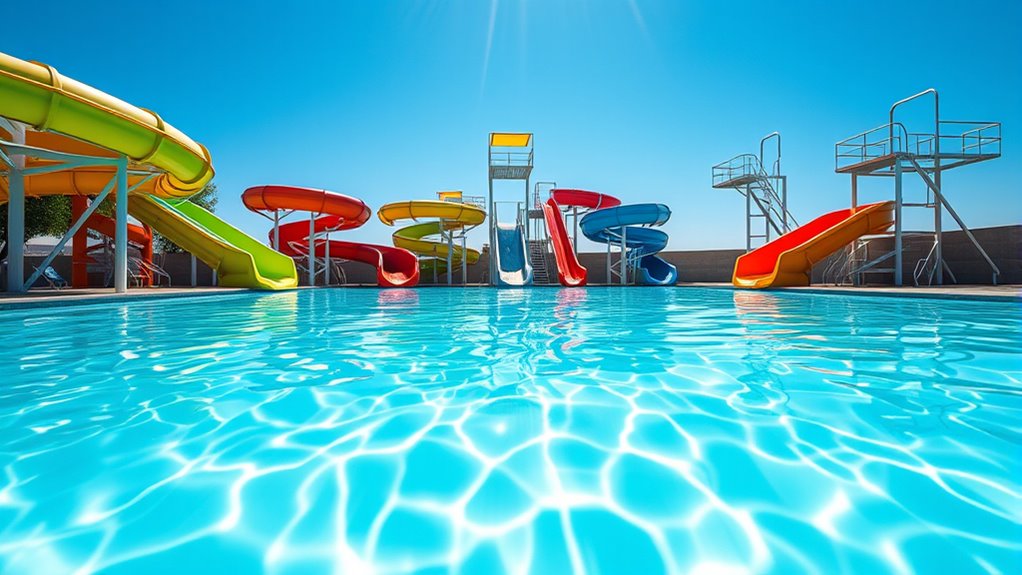
As a pool owner, you’re legally responsible for supervising swimmers and preventing accidents. You also need to guarantee safety equipment is in place and up to code. Understanding your liability and insurance obligations helps protect you if someone gets hurt on your property. Incorporating data-driven strategies can further minimize risks by implementing measurable safety protocols.
Supervision and Monitoring
When it comes to pool safety, supervising swimmers and monitoring the area are essential responsibilities for pool owners. Your constant vigilance helps prevent accidents and saves lives. Staying alert means watching for risky behaviors, quick to intervene if someone is in danger, and ensuring children are never left unattended. Proper supervision isn’t just about watching; it’s about actively engaging with swimmers to identify hazards early. Remember, even a moment of distraction can lead to tragedy. Your role is critical in creating a safe environment where fun doesn’t turn into heartbreak.
- Feeling the weight of responsibility every time someone enters the pool
- The fear of missing a key moment that could change lives
- The relief of knowing you’ve prevented a potential emergency
- The pride in safeguarding loved ones and guests
Safety Equipment Requirements
Ensuring your pool is equipped with the proper safety equipment is a legal requirement that can prevent accidents and save lives. You must install and maintain safety devices like life rings, reaching poles, and first aid kits nearby. Proper signage indicating pool rules and depth markers is also essential. These measures help alert swimmers to hazards and provide immediate assistance if needed. In some jurisdictions, pool covers with locking mechanisms or fences with self-closing gates are mandated to prevent unauthorized access. Regularly inspect and replace safety gear to guarantee it functions correctly. Additionally, compliance with local regulations is crucial to ensure you meet all safety standards and avoid potential legal penalties. By complying with these safety equipment requirements, you reduce the risk of injuries and demonstrate your commitment to safe swimming environments. Staying informed about local regulations is vital for lawful and responsible pool ownership.
Liability and Insurance
Pool owners have a legal obligation to understand and meet their liability and insurance responsibilities to protect themselves and others. If an accident happens, you could face costly lawsuits, medical bills, or even permanent injuries. Proper insurance coverage can shield you from financial ruin and provide peace of mind. Failing to carry adequate insurance or neglecting liability requirements can leave you vulnerable to legal action and hefty payouts. Developing a creative practice around safety measures and risk management can help in proactively addressing potential hazards.
Designing a Safe Water Play Area
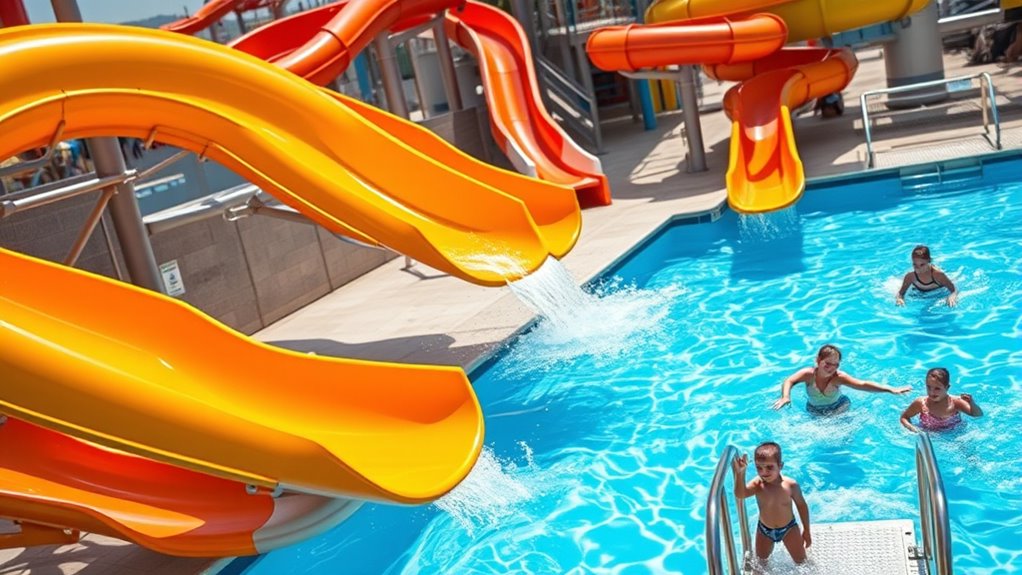
Designing a safe water play area requires careful planning to prevent accidents and guarantee fun for all users. You need to select appropriate equipment, set clear rules, and ensure proper spacing. Use impact-absorbing surfaces like rubber mats or sand to cushion falls, and design shallow zones for young children. Establish safety zones around slides and diving boards, keeping them free of obstacles. Regularly review the layout for potential hazards, adjusting as needed. Here’s a quick overview:
| Element | Considerations | Best Practices |
|---|---|---|
| Equipment Placement | Clear zones, away from obstacles | Maintain safe distances |
| Surface Material | Slip-resistant, impact-absorbing | Use rubber, foam, or sand |
| Signage & Rules | Clear instructions, age restrictions | Visible, easy-to-understand signs |
| Supervision | Trained staff, designated areas | Consistent oversight |
Proper design minimizes risks and promotes safe, enjoyable water play. Incorporating appropriate materials that align with farmhouse aesthetics can also enhance the overall environment and safety.
Proper Maintenance and Inspection Practices
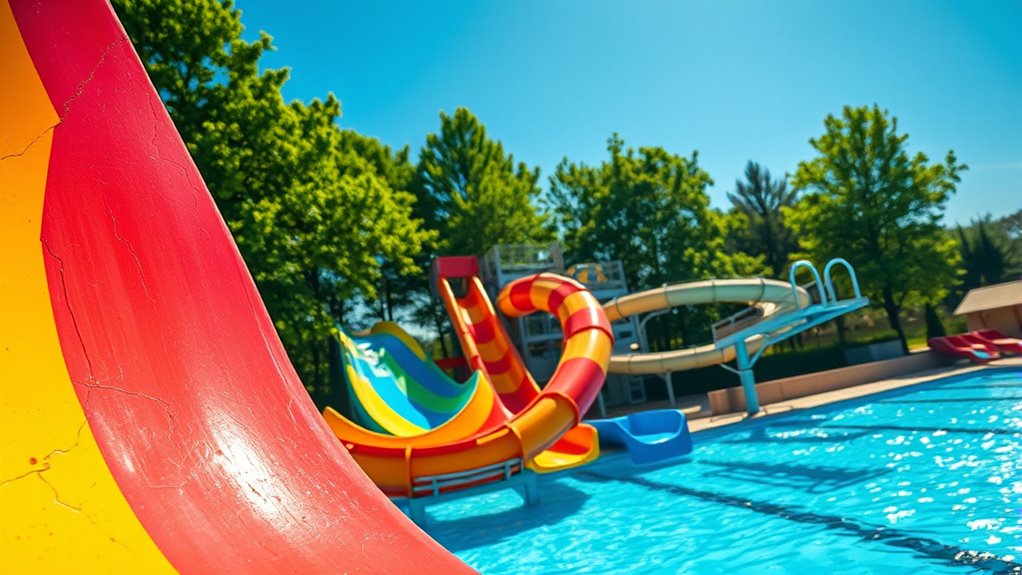
You need to regularly inspect your slides and diving boards to spot any signs of wear or damage. When issues are found, follow immediate repair protocols to address them promptly. Consistent maintenance guarantees safe enjoyment for everyone using your water play area. Incorporating routine inspections helps identify potential safety hazards before accidents occur.
Regular Inspection Routines
Regular inspection routines are essential to guarantee the safety and longevity of slides and diving boards. By regularly checking for damage, wear, or corrosion, you prevent accidents and extend the lifespan of your equipment. Consistent inspections help catch small issues before they become major problems, saving you time and money. When you stay vigilant, you protect users from injury and demonstrate your commitment to safety.
Remember, neglecting inspections can result in dangerous malfunctions, liability, and costly repairs. Make routine checks a priority, especially after harsh weather or heavy use. Your proactive approach creates a safer environment and preserves the fun for everyone.
- Feel the relief of knowing your equipment is safe
- Avoid the heartbreak of preventable accidents
- Experience pride in responsible maintenance
- Maintain trust and confidence with your community
Immediate Repair Protocols
When a defect or damage is identified during inspections, prompt and effective repair is crucial to maintaining safety and preventing further deterioration. First, assess the issue quickly to determine its severity. If it’s a minor repair, follow your established protocols to fix it immediately, ensuring the area is safe before users return. For more significant damage, shut down the slide or diving board and restrict access until repairs are complete. Use approved replacement parts and follow manufacturer guidelines. Document the repair process thoroughly, noting the issue, steps taken, and date of completion. Regularly review repair records to identify recurring issues. Acting swiftly minimizes liability and helps maintain a safe environment, protecting users from potential injuries and ensuring the equipment remains in prime condition.
Understanding Liability Insurance for Water Features
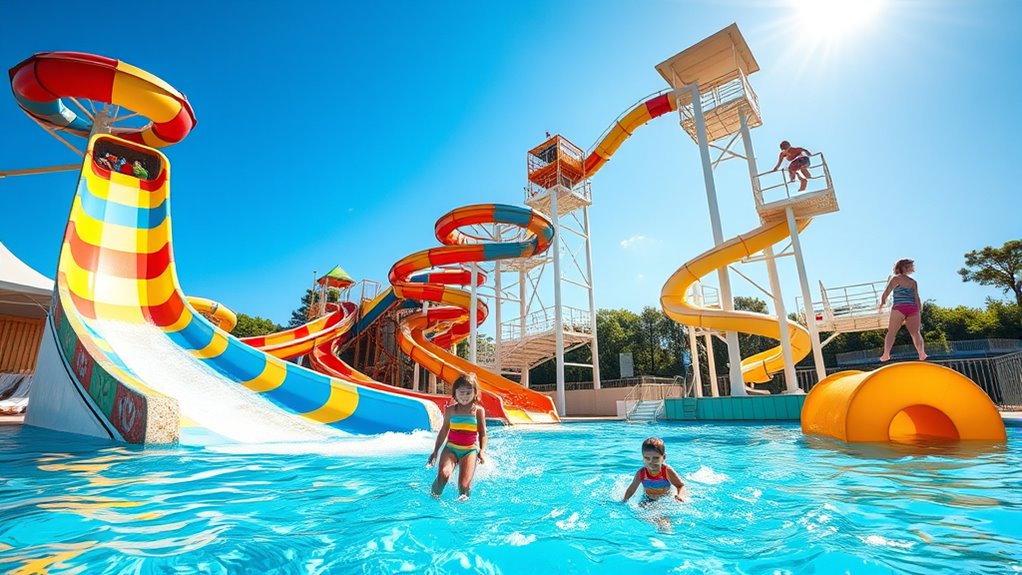
Liability insurance plays a crucial role in protecting property owners and operators of water features like slides and diving boards. It shields you from costly legal claims if someone gets injured on your equipment. Without it, a single accident could threaten your finances and reputation. Knowing your coverage options helps you prepare for unforeseen events and guarantees you can handle liabilities confidently.
Consider these emotional impacts:
- Protecting your peace of mind when hosting guests
- Securing your investment against potential lawsuits
- Preserving your reputation within the community
- Ensuring safety remains a priority, even in worst-case scenarios
Having the right liability insurance isn’t just smart—it’s indispensable for balancing fun and safety without risking everything you’ve built.
Implementing Safety Rules and Signage
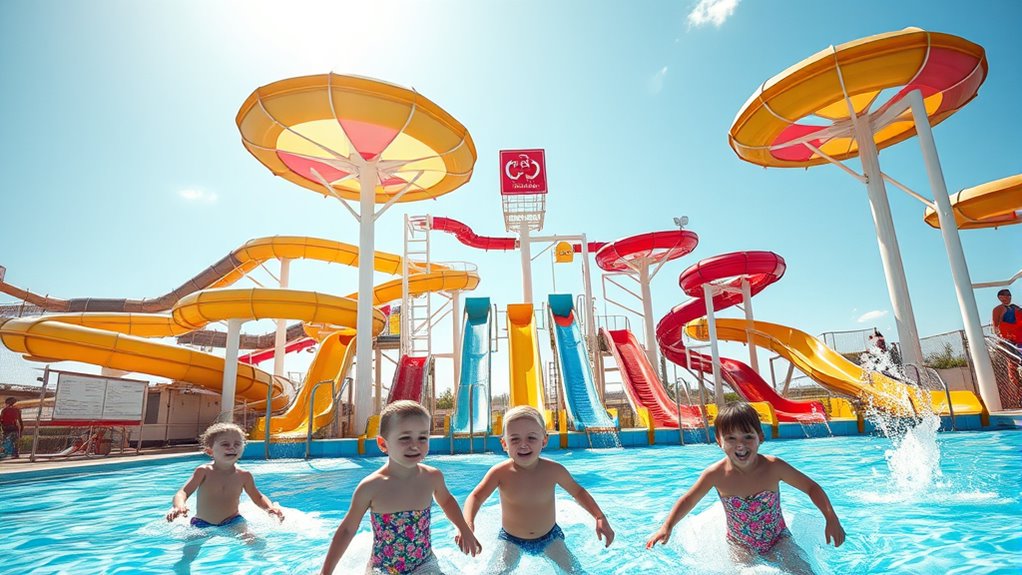
Implementing clear safety rules and prominent signage is essential to prevent accidents and promote responsible use of water features like slides and diving boards. You should display rules visibly at all entry points and ensure they’re easy to understand. Use simple language, symbols, and color coding to catch attention. Regularly update signage to reflect current safety standards and local regulations. Enforce rules consistently, and remind users about height, depth, and proper behavior. Proper signage helps users recognize potential hazards and understand safe practices. Here’s a quick overview:
| Safety Rule | Signage Tip |
|---|---|
| No running on decks | Use bold, large fonts with warning icons |
| Follow weight/height limits | Place signs at eye level near entry points |
| No diving in shallow areas | Use color-coded signs to indicate depth |
Training Staff and Supervisors Effectively
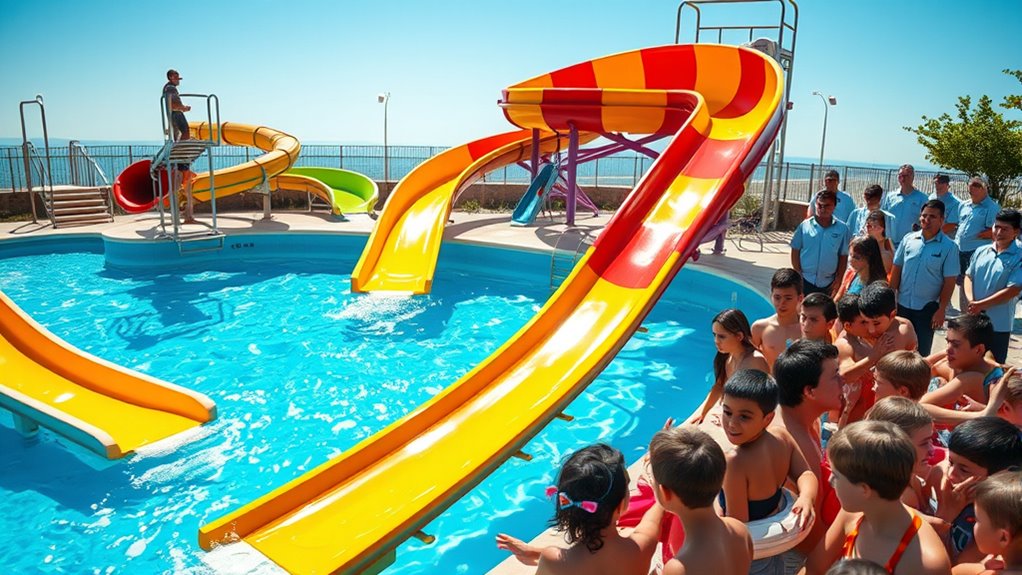
Effective training of staff and supervisors is essential to maintaining a safe and enjoyable environment around slides and diving boards. Well-trained personnel can spot hazards before they escalate and respond quickly during emergencies. You want your staff to understand safety protocols, recognize risky behavior, and communicate effectively with patrons. Proper training builds confidence, reduces accidents, and reassures visitors that their safety is a priority.
Remember, your staff’s actions can prevent tragedies and foster trust. Invest in ongoing education and practical drills to keep everyone prepared. When your team is knowledgeable and vigilant, it creates a safer space.
- Feel the relief of knowing your team is prepared for any situation
- Experience the pride of preventing avoidable accidents
- Witness the confidence your staff gains from proper training
- Know you’re protecting your guests and your facility
Case Studies of Water-Related Incidents
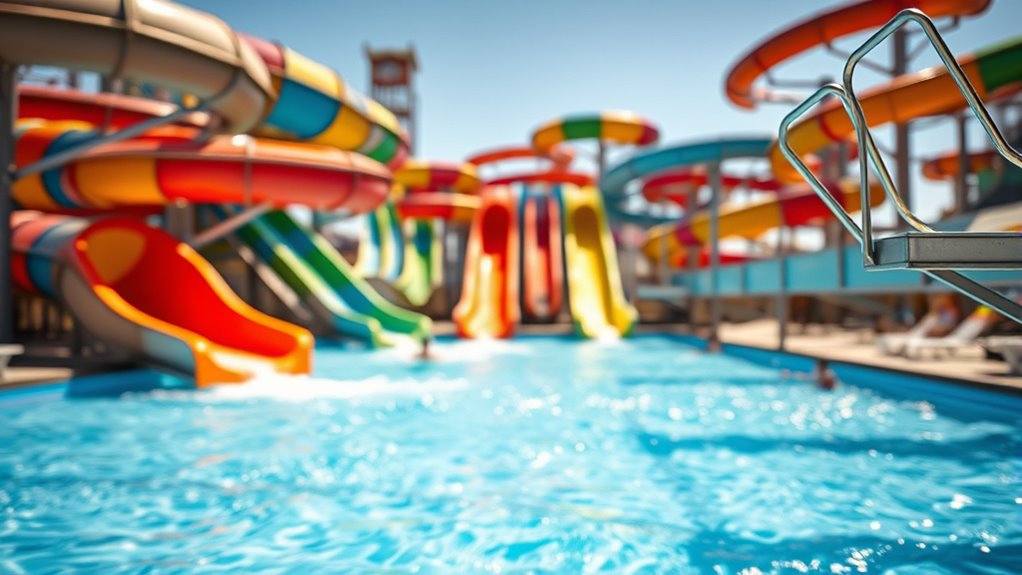
Examining real-life water-related incidents offers valuable lessons that can improve safety protocols around slides and diving boards. For example, a drowning incident at a public pool highlighted the importance of constant supervision and clear signage warning about depth. In another case, a child sustained a head injury after slipping on a wet deck near a diving board, emphasizing the need for non-slip surfaces and prompt maintenance. These incidents reveal common risks, such as inadequate supervision, poor equipment maintenance, or unclear rules. By studying such cases, you learn to identify hazards early and implement targeted safety measures. Understanding what went wrong allows you to prevent similar incidents, ensuring safer environments where fun doesn’t turn into tragedy.
Balancing Fun and Safety: Best Practices
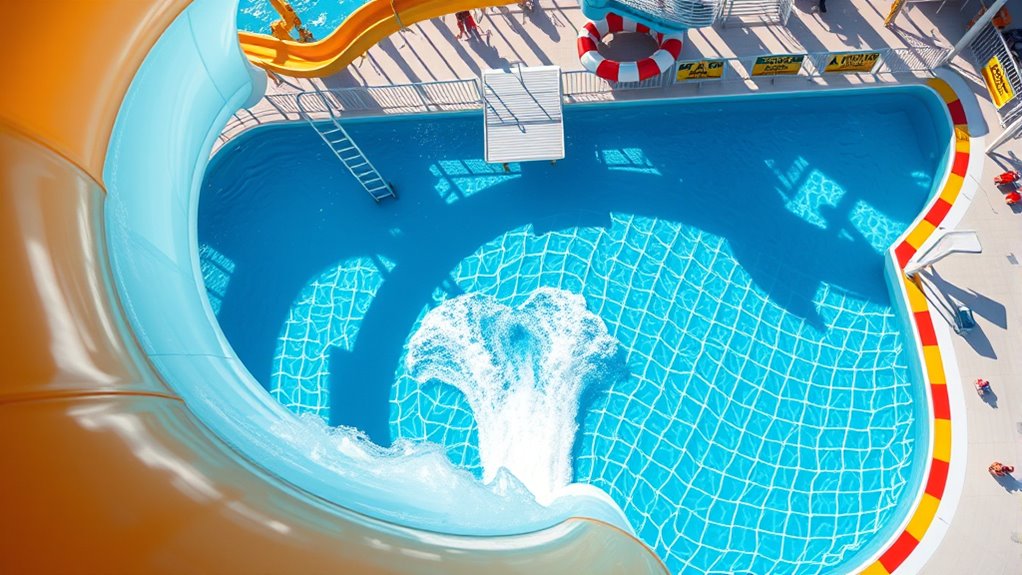
Balancing fun and safety on slides and diving boards requires a proactive approach that prioritizes guest enjoyment without compromising well-being. You need to implement clear rules, regular inspections, and staff training to prevent accidents. Creating a safe environment encourages guests to have fun while feeling secure.
To achieve this, consider these best practices:
- Ensure proper maintenance and timely repairs of equipment
- Enforce strict supervision and clear safety instructions
- Limit access based on age, height, or skill level
- Promote a culture of safety without dampening excitement
Frequently Asked Questions
How Do Age Restrictions Impact the Design of Water Slides and Diving Boards?
Age restrictions greatly influence the design of water slides and diving boards. You’ll need to incorporate safety features suitable for specific age groups, such as lower heights or softer landings for younger children. These restrictions also guide the use of barriers and signage to prevent unsafe use. By considering age, you guarantee the equipment is fun and safe, reducing liability and creating a positive experience for all users.
What Are Emerging Technologies Improving Safety in Water Play Areas?
Did you know that 70% of water park injuries are preventable with new safety tech? Emerging technologies like sensor-based monitoring, real-time impact detection, and augmented reality safety guides are revolutionizing water play areas. These innovations help you stay alert, respond faster, and reduce risks. By integrating these advancements, you can enjoy safer, more enjoyable water experiences while minimizing liability concerns. Safety is now more effective than ever.
How Do Weather Conditions Influence Safety Guidelines for Water Features?
Weather conditions heavily influence safety guidelines for water features. When it’s stormy, windy, or lightning is present, you should immediately suspend water activities to prevent accidents. Hot weather requires hydration and shade, while cold temperatures may necessitate limiting exposure to prevent hypothermia. You need to monitor weather forecasts closely and adjust safety protocols accordingly, ensuring all participants stay safe and informed, regardless of changing weather patterns.
What Training Programs Are Most Effective for Staff Supervision?
You should prioritize extensive training programs that combine hands-on instruction, safety protocols, and emergency response drills. Look for courses accredited by recognized organizations, and guarantee staff regularly update their skills. Effective programs emphasize active supervision, risk recognition, and incident management. By investing in ongoing training, you empower your staff to prevent accidents, respond confidently to emergencies, and maintain a safe, enjoyable environment for everyone.
How Can Pool Owners Balance Aesthetic Appeal With Safety Compliance?
You might find that combining sleek design with safety measures isn’t just possible but essential. Invest in high-quality, non-slip surfaces and clear signage, which experts confirm reduce accidents without sacrificing aesthetics. Regular maintenance and thoughtful placement of safety features can enhance visual appeal while meeting safety standards. By prioritizing both form and function, you guarantee your pool remains inviting and compliant, creating a space where fun and safety go hand in hand.
Conclusion
Balancing fun and safety is essential when it comes to water slides and diving boards. Did you know that nearly 70% of pool-related injuries involve slips or falls? By understanding risks, following safety protocols, and maintaining equipment properly, you can create a fun, accident-free environment. Prioritize safety rules, staff training, and regular inspections to protect everyone while still enjoying the thrill. Ultimately, responsible planning makes all the difference in keeping your water play area both fun and safe.
